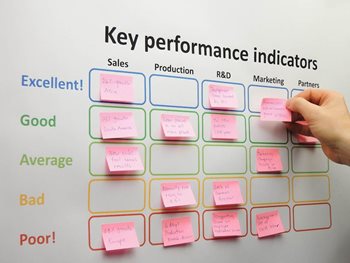To continually grow and develop as a business, it's important that you have goals to work towards.
These goals can come in many forms, from financial aims like raising revenue or profit margins by a certain percentage by the end of the year, to objectives that are less fiscally motivated but still vital to the company, like keeping your employees happy or becoming a more socially responsible organization.
You can boost your chances of success by ensuring you're taking the right approach to establishing targets and measuring progress towards them.
So what goal-setting frameworks are available for you to choose from, and what advantages do they offer?
1. SMART goals
One of the best-known goal-setting frameworks, the SMART structure helps you ensure your business objectives are:
- Specific - Ensure the goal in question is clear and detailed, so the key people responsible for working towards it are fully aware of what they're trying to accomplish, why it’s important and what processes are involved along the way.
- Measurable - You must be able to evaluate the headway you're making towards achieving your objectives. It's important, therefore, to ensure your goals have enough detail and data to enable regular tracking of your progress, which can support team engagement and motivation.
- Actionable - How will the goal be achieved? What is your action plan, and do you have the resources and capabilities required to achieve success? If not, what are you lacking? Well-designed goals provide clarity of action, and can be broken down into manageable, actionable sub-goals.
- Relevant - Why is it so important for the company to achieve this aim? What significance does it hold for you, and how does it relate to your other defining principles and priorities?
- Time-bound - Putting time at the heart of your goal-setting - for example, by establishing a clear final deadline or clarifying what milestones you want to achieve at particular points in the future - creates structure and reduces the risk of the project drifting on with no clear end point.
2. OKRs
Many businesses have been motivated to introduce OKRs (objectives and key results) after seeing the outcomes this approach has helped to deliver at hugely successful companies like Google.
The fundamental idea behind the OKR approach is that setting ambitious, challenging goals can make a valuable contribution to employee motivation and engagement. The 'key results' part relates to the data and metrics you use to measure progress and show how people are performing and developing.
According to Google, the "sweet spot" for an OKR grade is 60%-70%. One of the reasons for this is that if an employee is regularly attaining high scores and fully achieving their objectives, it's possible that their target isn't ambitious enough and they aren't being challenged.
3. 4DX
4DX refers to the Four Disciplines of Execution, as outlined in the book of the same name by Chris McChesney, Jim Huling and Sean Covey.
The structure is based on the idea that the execution of business processes and strategy often fails because of issues like managers and teams not knowing their goals, not having a plan to achieve them or not measuring progress towards accomplishment.
In an effort to address these problems, 4DX recommends:
- Focusing on 'wildly important goals' - This involves narrowing your focus and concentrating on the objectives that are fundamental to your success as a business.
- Acting on 80/20 measures - The 4DX approach is partly based on the idea that 20% of activities produce 80% of results. These processes should be "identified, codified into individual actions and tracked fanatically".
- Keeping a compelling scoreboard - Measuring performance and results in a positive, motivational way can deliver clear results in terms of team motivation and productivity.
- Creating a cadence of accountability - Teams and their members should stick to a system that provides regular opportunities to recognize success, analyze failures and make changes where they're required. The culture of accountability should be "positive and self-directed".
4. BHAG
BHAG stands for 'big, hairy, audacious goals', and refers to grand, ambitious objectives that might seem unrealistic in the short term but provide a valuable sense of aspiration and emotional drive to take the business forward.
The term - coined by Jim Collins and Jerry Porras in their book Built to Last: Successful Habits of Visionary Companies - generally describes long-term plans linked to the core values and principles at the heart of your business.
There's a strong argument to be made that companies that have transformed their industries, and in many cases the entire world, would never have reached such a level of success had it not been for their ambitious goal-setting.
Here are some examples of businesses that have been driven by the BHAGs they’ve set to inspire their employees:
- Microsoft - Put a computer on every desk and in every home
- Google - Organize the world's information
- Tesla - Accelerate the world's transition to sustainable energy
- Nike - Crush Adidas
Coming up with goals like these for your business can show competitors, staff and potential partners how serious you are about not just succeeding, but making a difference to the world.
Access the latest business knowledge in Management
Get Access







Comments
Join the conversation...